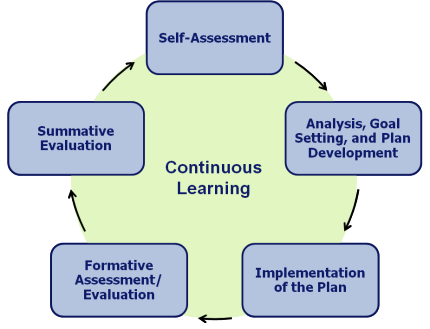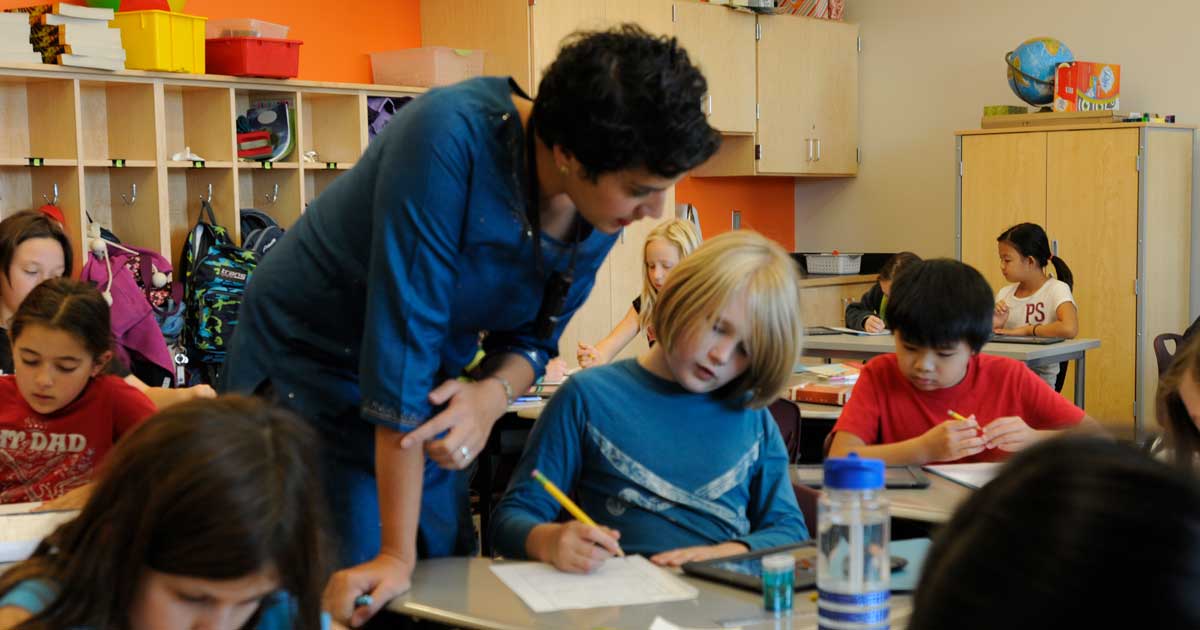- Standards: Performance standards encompass the broadly defined knowledge, skill and behavioral expectations for educators described in the four standards of professional practice for teachers and administrators.
- Indicators: Indicators articulate the knowledge, skills, and behaviors by which the educator will be judged to inform a performance rating on each standard. Each standard has at least one indicator; the number of indicators depends on the complexity of the standard.
- Descriptors: Descriptors define the individual elements of each of the indicators.
- Benchmarks: Benchmarks describe the acceptable demonstration of knowledge, skill or behavior necessary to achieve a performance rating. For each indicator, there are four benchmarks – one describing performance at each performance rating – EXEMPLARY, PROFICIENT, NEEDS IMPROVEMENT, UNSATISFACTORY.
Educator Evaluation

The Massachusetts educator evaluation system, adopted in 2011 by the Board of Elementary and Secondary Education, establishes standards and requirements for teachers and administrators. In 2017, the board made a major change to the evaluation system — eliminating a separate Student Impact Rating based on District-Determined Measures and instead requiring that student learning measures be included in the Summative Evaluation.
The core of the evaluation system is a five-step cycle.
The Five-Step Cycle
The educator evaluation system establishes standards for teachers and administrators and requires the following steps.
Self-Assessment
Step One: Self-Assessment
The entry point of the evaluation cycle is the self-assessment using the standards and indicators of effective professional practice from the appropriate rubric.

The focus of the self-assessment should include:
- Assessing the educator’s practice against performance standards;
- Analyzing previous evidence of learning, growth, and achievement of students under the educator’s responsibility;
- Determining the academic, social, behavioral and/or emotional needs of students under the educator’s responsibility;
- Proposing at least two goals:
- The Professional Practice Goal to improve or enhance professional practice.
- The Student Learning Goal to improve or enhance student learning, growth and achievement.
The educator uses the appropriate rubric to assess his/her performance against the four standards and indicators to determine areas of strength and areas needing improvement and/or enhancement.
Worksheet Guidance, Templates and DESE Self-Assessment Form
Rubrics
Types
Types of rubrics include: Teacher, Specialized Instructional Support Personnel/Caseload Educator and Administrator.
Standards
The educator considers evidence related to four standards and assesses his or her practice using the appropriate professional practice rubric.
Teacher, Specialized Instructional Support Personnel/Caseload Educator Administrator Curriculum, Planning and Assessment Instructional Leadership Teaching All Students Management & Operations Family & Community Engagement Family & Community Engagement Professional Culture Professional Culture Elements of Professional Practice Rubrics
Goal Setting and Plan Development
Step Two: Goal Setting and Educator Plan Development
Goal Setting
Goals may be developed by an individual educator or a team of educators who teach the same grade or the same subject or have the same or similar position in the school. Together they share area(s) of practice and student learning they would like to improve and draft SMART-ER goals that will be the basis for their educator plans.
MEET: The educator and colleagues meet with their supervisor to review the two goals they have developed. The supervisor/evaluator has final authority over the goals in the educator’s plan.
DEVELOP A PLAN: The educator or team then develops an Educator Plan for each goal that identifies professional development activities, work products, student work products and the support needed to attain the goals.
CONSIDER AVAILABLE RESOURCES: The educator shares their plan with the supervisor to determine resources that will be available to them. The plan may need adjusting if the school/district does not have the resources to support their work.
MTA Student Learning Goal Guidance
Student learning goals should be straightforward statements of what students should know or be able to do as a result of an educator's work during a specific instructional period.
Types of Educator Plans
Developing Educator Plan: For educators in their first three years of practice.
Self-Directed Plan: For educators who receive a proficient or exemplary rating.
- Educators whose students did not meet anticipated learning gains are placed on a one-year self-directed plan.
- Educators whose students met or exceeded anticipated learning goals are placed on a two-year self-directed plan.
Self-Directed Educator Plan Guidance
Directed Growth Plan: Educators who receive a needs improvement rating are placed on this plan for up to one year.
Improvement Plan: Educators who received an unsatisfactory rating are placed on this plan is for up to 12 months.
Plan Implementation
Step Three: Plan Implementation
Now the educator should complete activities and collect evidence during the agreed-upon timeframe. The supervisor conducts a series of unannounced – and announced – observations where he or she is expected to review both the educator's work products and the work of his/her students as well as interactions with students.
Now the educator should complete activities and collect evidence during the agreed-upon timeframe. The supervisor conducts a series of unannounced – and announced – observations where he or she is expected to review both the educator's work products and the work of his/her students as well as interactions with students.
Feedback & Evidence
Observations must result in measurable and actionable feedback to help guide educator practice.
Verbal Feedback
The observer talks with the educator for three to five minutes at a convenient time, away from students and colleagues and not during lunch.
- The observer shares one or two key points from the observation, with a focus on commending, questioning and/or correcting the educator.
- The educator provides the observer with information about the students, the lesson or what happened in the classroom or worksite before or after the observer’s visit to provide additional context or explanation.
Written Feedback
The observer should determine the appropriate evidence rating on the indicator elements and/or educator goals using the following measures.
- Exemplary: I saw clear evidence that the educator’s practice reflected the exemplary description in the rubric and that the educator could be a model for others.
- Proficient: I saw clear evidence that the educator’s practice reflected the proficient description in the rubric.
- Needs Improvement: I saw evidence that the educator’s practice reflected the needs improvement description in the rubric.
- Unsatisfactory: I saw evidence that the educator’s practice reflected the unsatisfactory description in the rubric.
- Not Observed: The educator’s practice did not include elements defined in the indicator. This is not a negative rating but an acknowledgment that the indicator was not addressed.
Collecting Evidence
The educator(s) keeps track of the work that is done to attain the plan’s goals and to document evidence of work related to the Professional Practice standards. Logs might include information and evidence related to teaching and learning, instructional leadership, school/district management & operations, professional development, parent/family engagement, professional responsibilities, and community engagement.
There has been an enormous amount of misinformation about the evidence requirement:
- Evidence by Standards, Not By Indicators: Evidence must relate to the four standards (add a link to rubric standards) and/or the professional practice goal and student learning goal. It is not necessary – or required – that there be evidence for each indicator. It is important to remember that practice is judged on each standard, not on each indicator. The collection and organization of evidence are the responsibility of both the educator and the evaluator.
- A Single Piece of Evidence May Relate to Multiple Standards: One artifact may be used to demonstrate proficiency on multiple standards and may apply to multiple indicators. For example, one standards-based unit of instruction may be used as evidence for Standards 1-4.
- Evidence May Relate to Educator Plan Goals: Some evidence may be clearly related to professional practice and/or student learning goals.
- Evidence Is a Sampling: For the most part, evidence should be a sampling of the work that educators perform and the resulting student work. Evidence is not meant to be inclusive of all that educators do. Evaluators may identify common artifacts, something that most educators are expected to provide, such as lesson plans or unit plans.
- Evidence Should Demonstrate Profiency: In the educator’s professional judgment, once sufficient evidence has been identified and/or collected to demonstrate proficiency on one or more standard, there is no need to add more. It may be helpful to provide the evaluator with a brief rationale for the use of each piece of evidence.
- Evidence Collection Methods: There is no requirement that educators collect evidence in binders. Unfortunately, some districts have contracted to use electronic evaluation systems that are driving the implementation. This is the tail wagging the dog. Districts should reconsider software systems that make unnecessary work for either the educator or the evaluator.
Performance Ratings
The goal is for educator practice to be rated as proficient. Educator performance on standards, indicators and overall will use the four regulatory ratings.
EXEMPLARY: The educator’s performance consistently and significantly exceeds the requirements of a standard or overall.
The educator demonstrates an extensive knowledge and skills defined in the standard and indicators and should be considered a “master” in this area. The educator should be modeling his/her practice for others; teaching others in professional development; coaching other practitioners.
PROFICIENT: The educator’s performanceeducator’s performance fully and consistently meets the requirements of a standard or overall. The educator demonstrates a solid understanding of the knowledge, content and skills defined in the standard and indicators. The educator’s performance consistently fulfills the position responsibilities, resulting in quality work that impacts student learning or behavior in a positive manner. A proficient rating is a high performance criteria expected of all educators.
NEEDS IMPROVEMENT: The educator’s performance on a standard or indicators is below the requirements for proficiency, but is not considered to be unsatisfactory at this time. Improvement is necessary and expected. The educator inconsistently meets responsibilities, resulting in less than quality work performance and poor student learning or behavior.
UNSATISFACTORY: The educator’s performance has not significantly improved following a rating of needs improvement, or the educator’s performance is consistently below the requirements for proficiency, is considered inadequate, or both. The educator does not adequately fulfill responsibilities, resulting in inferior work performance and negatively impacting student learning or behavior.
Formative Assessment
Step Four: Formative Assessment or Formative Evaluation
The supervisor periodically provides feedback to the educator about his/her performance in either a Formative Assessment or a Formative Evaluation.
Formative Assessments
- Required for all educators and generally occur midway through the evaluation cycle.
- Provide feedback to improve or enhance practice and/or outcomes. The goal is not to rate practice. If the evaluator believes that the educator’s practice has significantly changed, we recommend a formative evaluation that focuses on areas of deficiency with the goal of returning the educator to proficient practice.
Formative Evaluations
- Required only for educators on a two-year Self-Directed Educator Plan.
- If an educator receives a formative evaluation that differs from the summative rating the educator had received at the beginning of the evaluation cycle, the evaluator may place the educator on a different educator plan appropriate to the new rating.
Summative Evaluation
Step Five: Summative Evaluation
The five-step evaluation cycle results in a summative evaluation of the educator’s practice. The evaluator compiles evidence from multiple sources including observations and examination of work products as well as other relevant evidence for each of the four standards of professional practice as well as the Professional Practice and Student Learning Goals The educator should also provide evidence related to standards and goals. At the end of the cycle, the evaluator conducts a Summative Evaluation.
The Overall Performance Rating for all educators and administrators is informed by these six ratings:
- One for each of the four Standards of Professional Practice (Exemplary, Proficient, Needs Improvement or Unsatisfactory)
- One for the Professional Practice Goal (exceeded goal, met goal, sufficient progress, insufficient progress, no progress)
- One for the Student Learning Goal (exceeded goal, met goal, sufficient progress, insufficient progress, no progress)